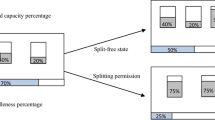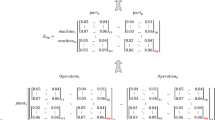Abstract
This paper addresses designing a dynamic cellular manufacturing system which considers optimizing batch sizes for inter-cell moves in order to pursue fundamentals of Just-In-Time production philosophy. To do so, a bi-objective mixed-integer nonlinear programming model is proposed with two conflicting objective functions: minimizing sum of machine purchasing, operating, inter-cell moves, machine relocation, and machine transferring cost, and minimizing work-in-process (WIP) with regard to inter-cell batch sizes. Also, the best time to sell unused machines is obtained by calculating their salvage values. Finally, the proposed model is validated using numerical experiments and hence, the resulted WIP inventories are assessed through the conducted numerical experiments, and sensitivity analysis is provided with respect to three major parameters (machine purchasing cost, inter-cell material handling cost, and part demand) applied in the proposed model.
Similar content being viewed by others
References
Selim MS, Askin RG, Vakharia AJ (1998) Cell formation in group technology: review evaluation and directions for future research. Comput Ind Eng 34:3–20
Aryanezhad MB, Deljoo V, Mirzapour Al-e-hashem SMJ (2009) Dynamic cell formation and the worker assignment problem: a new model. Int J Adv Manuf Technol 41:329–342
Defersha FM, Chen M (2006) A comprehensive mathematical model for the design of cellular manufacturing systems. Int J Prod Econ 103:767–783
Defersha FM, Chen M (2008) A linear programming embedded genetic algorithm for an integrated cell formation and lot sizing considering product quality. Eur J Oper Res 187:46–69
Nsakanda AL, Diaby M, Price WL (2006) Hybrid genetic approach for solving large-scale capacitated cell formation problems with multiple routings. Eur J Oper Res 171:1051–1070
Ahkioon S, Bulgak AA, Bektas T (2009) Cellular manufacturing system design with routing flexibility, machine procurement, production planning and dynamic system reconfiguration. Int J Prod Res 47(6):1573–1600
Ahkioon S, Bulgak A, Bektas T (2009) Integrated cellular manufacturing systems design with production planning and dynamic system reconfiguration. Eur J Oper Res 192:414–428
Rafiee K, Rabbani M, Rafiei H, Rahimi-Vahed A (2011) A new approach towards integrated cell formation and inventory lot sizing in an unreliable cellular manufacturing system. Appl Math Model 35:1810–1819
Rafiei H, Ghodsi R (2012) A bi-objective mathematical model toward dynamic cell formation considering labor utilization. Appl Math Model 37:2308–2316
Bortolini M, Manzini R, Accorsi R, Mora C (2011) An hybrid procedure for machine duplication in cellular manufacturing systems. Int J Adv Manuf Technol 57:1155–1173
Manzini R, Bindi F, Pareschi A (2010) The threshold value of group similarity in the formation of cellular manufacturing systems. Int J Prod Res 48(10):3029–3060
Tavakkoli-Moghaddam R, Aryanezhad MB, Safaei N, Azaron A (2005) Solving a dynamic cell formation problem using metaheuristics. Appl Math Comput 170:761–780
Gravel M, Nsakanda AL, Price W (1998) Efficient solutions to the cell-formation problem with multiple routings via a double-loop genetic algorithm. Eur J Oper Res 109:286–298
Muruganandam A, Prabhaharan G, Asokan P, Baskaran V (2005) A memetic algorithm approach to the cell formation problem. Int J Adv Manuf Technol 25:988–997
Prabhaharan G, Muruganandam A, Asokan P, Girish BS (2005) Machine cell formation for cellular manufacturing systems using an ant colony system approach. Int J Adv Manuf Technol 25:1013–1019
Dimopoulos C (2006) Multi-objective optimization of manufacturing cell design. Int J Prod Res 44(22):4855–4875
Dimopoulos C (2007) Explicit consideration of multiple objectives in cellular manufacturing. Eng Opt 39(5):551–565
Lei D, Wu Z (2006) Tabu search for multiple-criteria manufacturing cell design. Int J Adv Manuf Technol 28:950–956
Tsai C-C, Lee C-Y (2006) Optimization of manufacturing cell formation with a multi-functional mathematical programming model. Int J Adv Manuf Technol 30:309–318
Wu X, Chu C-H, Wang Y, Yan W (2007) A genetic algorithm for cellular manufacturing design and layout. Eur J Oper Res 181:156–167
Arkin F, Güngör Z (2009) Modeling of a manufacturing cell design problem with fuzzy multi-objective parametric programming. Math Comput Model 50:407–420
Ghotboddini MM, Rabbani M, Rahimian H (2011) A comprehensive dynamic cell formation design: Benders’ decomposition approach. Expert Syst Appl 38:2478–2488
Wang X, Tang J, Yung K-L (2009) Optimization of the multi-objective dynamic cell formation problem using a scatter search approach. Int J Adv Manuf Technol 44:318–329
Aramoon Bajestani M, Rabbani M, Rahimi-Vahed AR, Baharian Khoshkhou G (2009) A multi-objective scatter search for a dynamic cell formation problem. Comput Oper Res 36:777–794
Pitombeira Neto AR, Gonçalves Filho EV (2010) A simulation-based evolutionary multiobjective approach to manufacturing cell formation. Comput Ind Eng 59:64–74
Stawowy A (2006) Evolutionary strategy for manufacturing cell design. Int J Manag Sci Omega 34:1–18
Author information
Authors and Affiliations
Corresponding author
Rights and permissions
About this article
Cite this article
Rafiei, H., Rabbani, M., Nazaridoust, B. et al. Multi-objective cell formation problem considering work-in-process minimization. Int J Adv Manuf Technol 76, 1947–1955 (2015). https://doi.org/10.1007/s00170-014-6419-x
Received:
Accepted:
Published:
Issue Date:
DOI: https://doi.org/10.1007/s00170-014-6419-x




